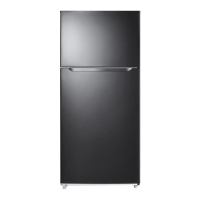15
Before You Call
CONCERN POTENTIAL CAUSE COMMON SOLUTION
Appliance
exterior surface
temperature is
warm.
1.
Appliance exterior
walls can be as much
as 30°F warmer than
room temperature.
2. Appliance too close to
adjacent surfaces.
1. This is normal while compressor works
to transfer heat from inside appliance
cabinet.
2.
See clearance requirements in the
Installation section of this Use & Care
Guide.
Louder sound
levels whenever
appliance is on.
Modern cooling
appliances have
increased storage
capacity and more stable
temperatures.
They require a high
efficiency compressor.
This is normal. When the surrounding
noise level is low, you might hear the
compressor running while it cools the
interior.
Longer sound
periods when
compressor comes
on.
Appliance operates
at higher pressures
during the start of the
ON cycle.
This is normal. Sound will level off or
disappear as appliance continues to
run.
Popping or cracking
sound when
compressor comes
on.
Metal parts undergo
expansion and
contraction, as in hot
water pipes.
This is normal. Sound will level off or
disappear as appliance continues to run.
Bubbling or
gurgling sound, like
water boiling.
Refrigerant (used for
cooling) is circulating
throughout the system.
This is normal.
Vibrating or
rattling noise.
1.
Appliance is not level.
It rocks on the floor
when it is moved
slightly.
2. Floor is uneven or
weak. Appliance rocks
on floor when it is
moved slightly.
3. Appliance is touching
the wall.
1. Level the unit. Refer to Leveling in
Appliance Setup section of this Use &
Care Guide.
2. Ensure floor can adequately support
appliance.
3. Move appliance slightly. Refer to
Leveling in the Appliance Setup section
after moving if necessary.
Moisture forms on
inside appliance
walls.
1. Weather is hot and
humid.
2. Door may not be
seating properly.
3. Door is kept open
too long, or is opened
too frequently.
1. This is normal.
2.
See Door Will Not Close in this Bef
ore
You Call section.
3. Open the door less often.
Moisture forms on
outside of
appliance.
Door may not be seating
properly, causing the
cold air from inside the
appliance to meet warm
moist air from outside.
See Door Will Not Close in this Before You
Call section.

